 |
|
|
 |
2004
November
29-30
|
And now it's a car-trap
Readers who enjoyed my
man-trap story will be
amused by the way the University of Georgia Health Service handles parking.
They have a gated lot.
People enter free of charge, but to get out, they must deposit a token which is
issued to them inside the building.
The computer doesn't keep track of whether the lot is full.
Or if it does, it counts handicapped spaces and employee reserved spaces as empty.
So Melody and Cathy drove in... found no legal parking spaces available... and
couldn't get out.
They took an employee's reserved space because nothing else was available, and went
into the building.
The security guard warned them about a $40 fine,
then muttered something about "entrapment" and didn't ticket them.
I'm very busy. More news (and the rollover to December's blog) may have to wait a
couple of days. Happy new month!

|
 |
2004
November
28
|
First Sunday in Advent
The Magnificat or Song of Mary:
"My soul magnifies the Lord,
and my spirit rejoices in God my Savior,
for he has looked on the humble estate of his servant.
For behold, from now on all generations will call me blessed;
for he who is mighty has done great things for me,
and holy is his name.
And his mercy is for those who fear him
from generation to generation.
He has shown strength with his arm;
he has scattered the proud in the thoughts of their hearts;
he has brought down the mighty from their thrones
and exalted those of humble estate;
he has filled the hungry with good things,
and the rich he has sent empty away.
He has helped his servant Israel,
in remembrance of his mercy,
as he spoke to our fathers,
to Abraham and to his offspring forever."
- Luke 1:46-55 (ESV)
This hymn (in Latin, Magnificat anima mea Dominum...)
has been a staple of Christian worship for nearly two thousand years.
It has been set to music many times; my favorite setting is a modern one by
Timothy Dudley-Smith, "Tell out, my soul, the greatness of the Lord..."
Happy First Sunday in Advent!
Scripture quotations are from The Holy Bible, English Standard Version, copyright 2001
by Crossway Bibles, a division of Good News Publishers. Used by permission. All rights reserved.

|
 |
2004
November
27
|
M42 by moonlight
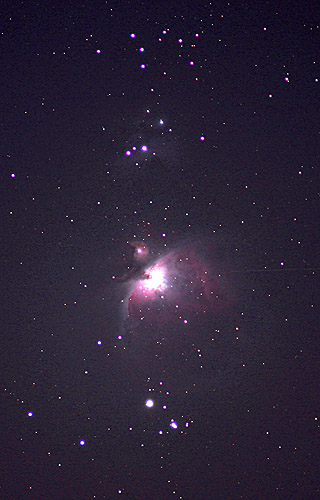
|
|
This is a fairly nice picture of the Orion Nebula, if I may say so myself.
It was taken under conditions that border on the preposterous.
The sky was nice and clear, all right, but the full moon was just 34 degrees away.
I could barely see the bright nebula (M42) through the telescope.
I took this last night in my backyard, using a mongrel camera that I call
my Nikocanolympus - Nikon lens, Chinese-made adapter purchased on eBay,
Canon Digital Rebel body, and Olympus Varimagni Finder.
The lens was a Nikon 300-mm f/4 EF IF AF, wide open, and the exposure was just 3 minutes,
followed by a matching dark frame, which was subtracted using
BlackFrame NR.
The photograph shows stars to 14th magnitude and includes the rarely observed
nebula NGC 1977, visible as a blue cloud around the group of stars above the center
of the picture.
The barely-visible
streak at the right is apparently a geosynchronous satellite, orbiting above
the earth's equator and slowly crossing the Orion Nebula as seen from our latitude.
|

|
 |
2004
November
26
|
Computers of the future?
[UPDATE: The picture below is not authentic. Even before I could get to the
library to try to find it in Popular Mechanics, Pete Albrecht wrote to let me know
it has been debunked here.
I was wondering about that teletype, which looks like something from the 1970s.
Also, the hovering TV looks a bit suspicious...and it turns out that Darren Casella's
remark about the submarine was right on the money.]
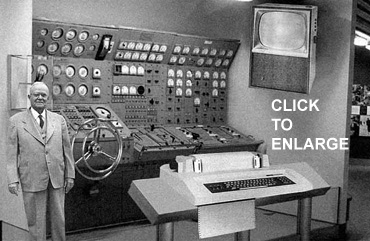 Back in 1954,
this is what the RAND Corporation thought the personal computers of 2004 would look like.
Back in 1954,
this is what the RAND Corporation thought the personal computers of 2004 would look like.
The teletype interface and the TV screen I'll believe.
And the prediction of the FORTRAN language wasn't far off the mark - BASIC is FORTRAN's direct descendant.
But what are all those gauges and dials for?
And the big steering wheel on the left?
Is this a computer, or the controls of a steamship?
(Actually, graduate student Darren Casella tells me the console in the background is a
submarine control system simulator. Hmmm...)

|
 |
2004
November
25
|
Thanksgiving
 I want to wish everyone a happy Thanksgiving Day. For those outside the U.S., I should explain
that this is the day we traditionally spend feasting on turkey and (if we're pious enough) thanking
God for His blessings.
I want to wish everyone a happy Thanksgiving Day. For those outside the U.S., I should explain
that this is the day we traditionally spend feasting on turkey and (if we're pious enough) thanking
God for His blessings.
(In our case, since there are only four of us, the turkey was actually a roasting hen.)
American schoolchildren are taught that Thanksgiving originated with the Mayflower Pilgrims in 1620 or
1621. In fact, however, Europe has had harvest festivals for many centuries.
Thanksgiving Day was promoted by George Washington but
wasn't a national holiday in the United States until 1941.
Anyhow, thankfulness is a good thing.
If you can't thank God, at least thank a human being for your good fortune.
And if you don't feel thankful, ask yourself this: Where does it say in my contract
that I'm entitled to everything I have, or things I don't have?
Who did I make that contract with? Did I ask to be born on specified terms only?
As Samuel Johnson noted, even "the consciousness of being" is a blessing to be thankful for.
I know what I'm thankful for today.
It's November 25, the 29th anniversary of
the
day I met Melody.

|
 |
2004
November
24
|
Yikes! It's the "Holiday Season"!
A brief walk at the mall this afternoon convinced me that this year's so-called
"Holiday Season"
(you can't call Christmas Christmas any more) will be one of the
looniest ever.
The mall is going to open at 6 a.m. Friday for people who want to be first in line...
for what exactly? I never found out. Are they actually going to run out of anything
before February?
Not only can't they call it Christmas, they can't play Christmas carols any more either.
That leaves them with "Jingle Bell Rock" and "Blue Christmas" and "I'll Be Home for Christmas"
and not much else.
Today I heard those songs over and over enough times to last the rest of the century,
so I think I'll be avoiding the mall for a while.

|
 |
2004
November
23
|
Classic astrophotography publication on line
Harvard University has made the entire text of the AAS Photo-Bulletin
available on line here.
Published from 1969 to 1986, the Photo-Bulletin was professional astronomers'
astrophotography journal.
During its brief lifespan, great steps were taken to turn astrophotography from an art
into a science.
So far I've skimmed the first 20 issues.
Some gleanings:
- Preflashing is a promising technique that we should still be using when we take
astronomical pictures on film.
- Hydrogen hypersensitization was a major discovery in the 1970s and the subject
of numerous articles.
- Unsharp masking was introduced to astronomy by David Malin. In those days it
literally meant making an unsharp mask - a blurred, low-contrast positive - which then was
sandwiched with the negative to reduce the contrast of large features while leaving small
features unaffected (and thus emphasizing them). Nowadays we do it digitally.
- The percentage of sharp frames in a video recording of the planets is
roughly inversely proportional to the square of the aperture.
That means
webcam astronomy
is especially suited to small telescopes.
The Photo-Bulletin gave only a brief summary of an
article by D. L. Fried in Journal of the Optical Society of America 68 (1978)
which I have yet to look up.
I found articles by Bart J. Bok (one of the great
characters of 20th-century astronomy)
and even by his student, the late
Julian J. Schreur
(who was the first professional astronomer I ever met,
at Valdosta State College in 1970, when I was fresh out of middle school and hanging around their observatory).
This material wasn't available to me when I was writing the original edition
of Astrophotography
for the Amateur, except for a few articles that were sent to me by individuals.
I wish I'd had it - but I'm also a little surprised at how little I had missed, and
how close the amateur state-of-the-art was to that of professionals.

|
 |
2004
November
22
|
Kinds of interaction between science and religion
I'm reading a very interesting book,
Science and the Trinity,
by John Polkinghorne, a quantum physicist who is now also an Anglican minister and theologian.
One of Polkinghorne's main ideas is that modern science has much to contribute to theology - not just knowledge
of the world, but also tools of thought for dealing with complexity and the relation of structure to function.
So our understanding of the Father, Son, and Holy Spirit no longer has to be made entirely out of Plato and
Aristotle's metaphysics.
But I haven't read far enough to see what he does with that.
What I have read is his classification of ways other people have tried to link science with theology.
He identifies four approaches:
Deistic or "hands-off God": God is the ultimate order or cause of the universe, but not much more.
In its details, this concept of God is a long way away from religion as we know it.
Theistic, which is explicitly Christian but lacks the full depth of Christian theology;
it becomes like the deistic
approach as you get closer to important issues.
Revisionary, which wants theology to be reworked on the basis of scientific insights,
replacing important doctrines with newer concepts (e.g., "evolutionary theology").
Developmental, in which science helps to develop, but not replace, theology as we know it.
This is Polkinghorne's own position.
He maintains that mankind's understanding of God has plenty of room to grow, but
everything needs to "grow from a scriptural seed," preserving and deepening rather than
rejecting what has been understood in the past.
There is of course also what we might call the isolation position, which holds that
scientific and religious knowledge are so different that they don't interact.
This is how many churchgoing scientists actually operate, but it's clearly a mistake.
And I want to add one more: counter-revisionary, which is the position of people who want
substantial parts of science to be thrown out
on theological grounds rather than the other way around.
This ranges from amateurish "creation science" to serious
arguments for intelligent design.
Polkinghorne doesn't even mention this.
I think it has the same weaknesses as the position he calls revisionary;
it's the other side of the same coin.

|
 |
2004
November
21
|
Sweet 16

|
Yesterday was Sharon's
16th birthday, and today we celebrated it with candles on a brownie.
My children are almost grown up and I feel old!
We gave Sharon a Playstation 2 (with Dance Dance Revolution, the game where
you stomp on a matrix of pads in exactly the right sequence) - and the
poor girl has been too busy studying Latin to unpack it!
Te amo, filia mea.
|

|
 |
2004
November
19-20
|
Nice pictures
Some satisfying food for the eyes:
Orion Nebula by Scott Hammonds
Aurora borealis by Mike Hollingshead
Green anole by Bret Douglas
The latter two galleries are of pictures taken with Canon digital SLRs.

|
 |
2004
November
18
|
Don't work for an idiot
There's an interesting item in
CNET today about
dissatisfaction with long working hours and high pressure
in the software industry
(along with an interesting lawsuit under California's labor laws).
This started in the 1980s, when the idea was that you could get rich by being a computer
maniac and hiring more computer maniacs to work for you in the rat race to develop new products.
The reason for the rat race is that as soon as a new technology became available - such as
color graphics, hard disks, or faster modems - everybody would be scrambling to make and sell
software products that put it to use.
The fastest one generally won.
Not always... but that was the expectation.
Unfortunately, inept management became traditional in the industry.
Young computer hobbyists didn't know how to manage projects - nor did they
recognize bad management when they saw it.
Let me put it bluntly. Long hours and deadline crises are the result of ineptitude, not dedication.
If management can't allocate enough resources to a project, or can't estimate what will be needed,
that's management's fault.
Moreover, a deadline crisis is not an emergency.
It's a symptom of a project management failure.
What should be done? Two things:
Workers simply shouldn't put up with some of what goes on in the computer industry.
Enthusiasm is good. Voluntary long hours are good, when driven by enthusiasm and
compensated by adequate rest at other times. Brief deadline crunches at strategic
times are acceptable. Continuous "crunch mode" and artificial deadline crises are not.
Teachers should forewarn their students about bad management.
I know I do. I put it bluntly: We are not training you to work in a sweatshop.
There are jobs you should have the good sense not to take.
In some other professions, such as architecture and graphic design, excessively long hours
and artificial deadline crises are unfortunately considered normal, and students
are "prepared" for them by having to work under similar conditions.
I think this is a load of rubbish.
As I said, we are not training our students to work in sweatshops.

|
 |
2004
November
17
|
No news...
No notebook entry today,
but lots of phototechnical goodies here.

|
 |
2004
November
16
|
Some deep thinking
It's not every day that one of our former graduate students writes a major
philosophical book.
But Gregg Rosenberg
has done so.
His book is titled
A Place for Consciousness
and has just been published by Oxford University Press.
You can order it from
Amazon
or read a draft of it
on line.
The book is basically an attack on physicalism.
For the past century, almost all scientists and many philosophers have maintained
that only physical objects are "real" (whatever that means).
Everything else - minds, thoughts, emotions, laws, governments, works of art, and even science itself - is
either a byproduct (fundamentally unimportant) or an illusion.
Plenty of people have claimed to explain the conscious mind, when all they really did was
wave their hands and declare that an explanation was possible.
What Gregg wants to do is develop a way of analyzing the world that is rich enough
to admit that conscious experience is real,
without abandoning science as its basis.
To my delight, the book is very clearly written, in a lively style that shows a sense of humor.
That does not mean it's shallow.
The reasoning is complex and subtle, and it's going to take me a while to work through it.
I should also add that despite a similar starting point, this book is not
connected with
Nancy Pearcey's defense of theism.
As best I can tell, Gregg doesn't say anything about religion at all.

|
 |
2004
November
15
|
A vintage Hollywood collectible?
Back in 1983, when Melody and I lived in Los Angeles,
we spent a day exploring
the camera stores of Hollywood.
At one of them (Sunset Photo, as best I recall) there was a junk table with an
old (1965?) Soligor 400-mm f/6.3 telephoto lens priced at $20.
We snapped it up.
Melody's famous picture of the 1984 solar eclipse, published in
Astrophotography for the Amateur,
was taken with this lens.
And just yesterday I finally got around to taking an interesting picture with it myself.
It's a T-mount lens, which means there is no aperture coupling
and it can be adapted to any kind of camera - including Canon EOS.
So I put it on the EOS Digital Rebel yesterday afternoon,
walked out into the back yard,
and snapped a couple of pictures, handheld, at 1/400. This was the result...


|
 |
2004
November
14
|
First light
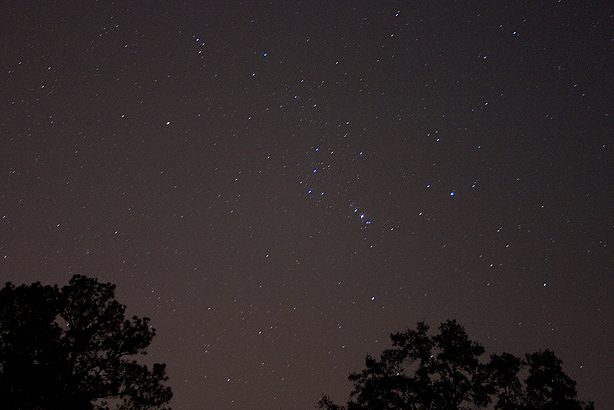
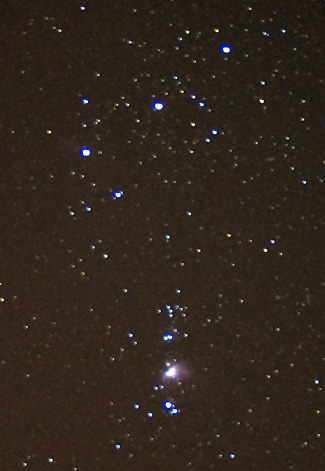
"First light" is what astronomers call it when a telescope or other instrument is
used for the first time.
In this case the instrument is our new Canon Digital Rebel, and the first picture is a
30-second exposure, on a fixed tripod, of Orion rising, with the lens set at 24 mm and f/3.5
and the camera set to ISO 400.
The stars are slightly elongated by the earth's rotation.
This is hardly a suitable lens for astrophotography, and I'll soon have an adapter to
use my existing Nikon lenses.
But what's noteworthy is the quality of the images.
"Hot pixels" were simply not a problem.
I did some 5-minute exposures, such as the second picture
(lens zoomed out to 55 mm, f/5.6, piggybacked on a telescope)
and hot pixels still weren't a problem.
It appears that the internal mechanism of this lightweight autofocus lens
may have shifted a little during the exposure, resulting in skewed star images.
But I reached stars down to magnitude 10.0 with an aperture of 10 mm in a five-minute exposure.
That implies that with my Nikon 300-mm f/4 lens, I should be able to hit magnitude 14 in 10 minutes;
or with an 8-inch telescope, magnitude 17.
For astrophotography, this camera isn't quite as good as the best fine-grained slide film,
but it is going to be very, very useful.
It is easily as good as Tri-X Pan or other classic high-speed films.
Heart-feast: November 14 is a family holiday in our house, a day of thanksgiving for
Melody's successful emergency heart valve replacement on November 14, 2001, and her slow
but successful recovery. Deo gratias agimus.

|
 |
2004
November
13
|
Using non-Canon flash with the EOS Digital Rebel (EOS 300D)
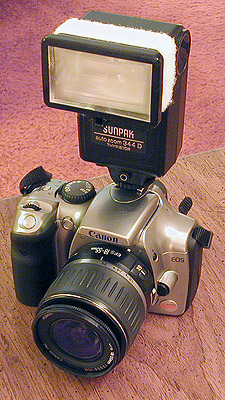 One of the purposes of this notebook is to record useful technical information so
that other people can find it. Accordingly, here are some notes on how to use a
non-Canon (and not Canon-dedicated) flash unit with the EOS Digital Rebel (EOS 300D).
One of the purposes of this notebook is to record useful technical information so
that other people can find it. Accordingly, here are some notes on how to use a
non-Canon (and not Canon-dedicated) flash unit with the EOS Digital Rebel (EOS 300D).
Note: I decided to move those technical notes to an
ad-sponsored page here as
part of a system of pages I'll build of notes about digital SLRs.
Please pardon my fickleness...

|
 |
2004
November
12
|
Gambling - a big risk
I'm too busy to write much today, but I want to draw your attention to a recent
incident
in which a University of Georgia student allegedly ran up $5,000
of gambling debts on his roommate's credit card,
and an
opinion piece
in the student newspaper
pointing out the seriousness of the current gambling craze.
How could somebody run up gambling debts on a credit card in Georgia, where
almost all gambling is illegal?
The Internet.
Just as the world was blind to the potential of Internet fraud ten years ago,
today they're blind to Internet gambling.
That, and for some reason, existing laws are just being ignored.
As far as I understand it, gambling "by wire" is still against federal law except in the special
situation where it is legal in the locations of both the gambler and the casino
(which rules out Georgia).
But Internet gambling is the current craze.
Local private gambling, such as poker games, has also suddenly become faddish - after years
of obscurity.
I haven't considered these small games
a serious problem because the stakes are low.
But they're part of a bigger trend that leads people to give their credit card numbers
to unidentified dishonest characters on the Web.
And that is a problem.
Actually, stealing a roommate's credit card number is a moderately common
crime of stupidity on the part of students.
I call it a crime of stupidity because I can't imagine how anybody could
expect to get away with it.
It's rather like a state employee using his government
credit card for personal purchases - which
is also common, and stupid.

|
 |
2004
November
11
|
Canonized?
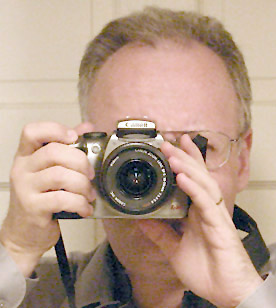 Our new Canon Digital Rebel came today - and, apparently, just in the nick of time,
because some slide film I had sent to my regular lab,
Colorchrome Atlanta, had
come back with a note saying they no longer process film.
Colorchrome is now a purveyor of large digital prints and the like.
Our new Canon Digital Rebel came today - and, apparently, just in the nick of time,
because some slide film I had sent to my regular lab,
Colorchrome Atlanta, had
come back with a note saying they no longer process film.
Colorchrome is now a purveyor of large digital prints and the like.
I'm going to try another Atlanta pro lab,
Color Genesis.
I could of course just send the film to Kodak, but these pro labs use a
"dip-and-dunk" process that is less likely to scratch the film.
When I enhance astronomical pictures (photographically or digitally),
it often brings out scratches that would be invisible in ordinary use.
Obviously, it's time to move even more thoroughly into digital imaging.
Whether I'll stick with Canon, I do not know. I may well switch to a Nikon digital SLR
when one is available that will do what I need to do.
Right now, Canon's CMOS sensors have the advantage for astrophotography.
But Nikon has CMOS sensors in the works (including one on their new D2X)
and I'll be evaluating some Nikon cameras soon.
My lenses are all Nikon, and if you stick with Nikon, you have
access to a wide range of older lenses secondhand.
On the other hand, Canon is taking the world by storm.
I once remarked that Olympus has a loyal following, but Nikon has an army.
To this I now add that Canon has a huge crowd...
By being less technologically conservative, and by addressing all markets
from consumer to high-end professional, Canon brings newer technology to us faster.
Nikon sells high reliability more than innovation.
Pictures for sale: High-quality color prints of some of my
astronomical photographs are being sold locally at
Elements Art Supply in Athens, Georgia.
The pictures are mostly from the selection shown
here.
Happy Veterans' Day!
I'm not sure any of us have given enough thought
to the fact that we have our freedom because people have been willing to die for us.
And I do mean Veterans', not Veteran's.
There was more than one of them.
Speaking of grammar, have you ever been told to capitalize all the important
words in a book title? That's the normal practice, but nobody ever tells you
what an "important" word is.
After considerable pondering, I think I have the answer: an "important" word
is one that can be pronounced with full emphasis without unnatural effect.
What matters is not the length of the word, but its role in the sentence.
Example: Things we've Seen and Not Seen. It seems natural to
capitalize not because it is spoken with full emphasis.
You might even capitalize we've for the same reason.
You get the idea. Or maybe You Get the Idea!

|
 |
2004
November
10
|
Moon vs. Jupiter
 This is perhaps the worst astrophoto image I've ever shared with the public,
but it records an interesting event.
Yesterday morning the moon passed in front of Jupiter
(the bright spot at the lower right).
This is perhaps the worst astrophoto image I've ever shared with the public,
but it records an interesting event.
Yesterday morning the moon passed in front of Jupiter
(the bright spot at the lower right).
Everything happened in the daytime sky; if it hadn't been brilliant blue, very clear,
we probably couldn't have seen it at all.
If it had happened at night, it would have been a spectacular sight to the unaided eye.
As it is, it was a matter of pale white on light blue...
I missed the disappearance at 11:20 a.m. by arriving at my telescope about 5 minutes late.
(I was slightly unsure of the time.)
I saw the reappearance at 11:58 using 9x63 binoculars on a tripod; by then the moon was
behind the trees as seen from my telescope pier, so I had to move a few yards to the west.
Then I held my Nikon Coolpix 990 up to the eyepiece of the binoculars and got a very low-contrast
picture. Raising the contrast, to make the moon clearly visible, brought out a tremendous
amount of noise (irregularity) in the Coolpix's sensor.
The hiding of one celestial object by another (usually the moon) is called
an occultation and is of interest because it's an opportunity to measure
positions in the Solar System very precisely.
For this reason, numerous amateur astronomers time every occultation of a bright star.

|
 |
2004
November
9
|
Color management comes to Covington Innovations
 I spent the last 2 evenings setting up color management on our Epson R300 printer
and the computer attached to it.
I spent the last 2 evenings setting up color management on our Epson R300 printer
and the computer attached to it.
This involved purchasing and using a
Monaco
EZcolor and Optix package
comprising a colorimeter for measuring screen color temperature, plus software for calibrating
scanners and printers.
And then figuring out how to use it...
The trouble with color management is that nearly all the documentation seems to be written
for people who either know it all already, or don't know anything about it.
The key idea is that the operating system associates a file called a color profile with
every screen, scanner, and printer.
For the printer there can be, and often are, different profiles for different kinds of paper.
Because screens and printers produce colors in different ways, they never match perfectly,
but by using color profiles, you can keep the discrepancies down to a level that doesn't seem unnatural.
Manufacturers provide color profiles for most printers and some screens.
The Monaco device helps you create a better color profile for your screen and - more importantly
in my case - adjust the screen to behave more normally.
It helped me get rid of the blue cast that plagued my 17-inch flat panel,
meanwhile providing reassurance that I wasn't going to get freakish-looking color.
This was done, not with a color profile, but by adjusting the monitor's own R, G, and B levels
using the buttons on its front panel
while the colorimeter watched and gave feedback.
Then Monaco's software took me through the profile creation process.
With my Epson R300 printer, there's a further twist: it is very easy to end up sending
your output through a color profile more than once, producing awful prints!
We found a very helpful document from Kodak
(included with any of their
paper color profiles)
that explains exactly how to use color profiles with Photoshop.
After trying out printer profiles from several sources - Kodak, Epson, and one our own that
we made with Monaco EZcolor -
we documented our own methods here and here.
Monaco EZcolor does not let you edit just any color profile - only those of its own, which
presumably are within some limits of complexity.
You don't need the colorimeter in order to customize a printer profile.
What you do is start with Monaco's default profile, print something, and compare it to the image
on the screen.
Whether or not you like the print, you then adjust a lot of sliders so that the screen matches it.
In this way you are telling EZcolor what changes to make.
Update the profile and go through the cycle again.
Please note that we do not have any further documentation to share and cannot help others
with color management unless they want to hire me (or more likely Melody) as a consultant.
(That is, please don't e-mail me asking how to do all of this with some other printer...)
Color management a messy business!
But the end result, even with only a rough calibration, is much better than conventional
color photography. Color film and paper, with three colored layers that have to be developed
together, just doesn't give you enough control.
The image of the palette came free of charge from
hasslefreeclipart.com.

|
 |
2004
November
8
|
Post-election madness
Ever since the election, we've had remarkable outpourings of fury, frustration,
despair, and now at least one
suicide (one of my computer
colleagues at the University of Georgia, though I don't think I knew him personally).
Several newsgroups that I read are being spammed mercilessly by political cranks, mostly left-wing,
but a few right-wing.
Why can't we all just get along?
People who are feeling post-election fury need to ask themselves seriously
whether they believe in democracy.
The American voters got what the majority of them asked for.
Is that, deep down, a bad thing?
The other thing I find incongrous about the whole situation is that there was
relatively little difference between Kerry's and Bush's platforms.
Neither one was against the war, which is our main national controversy.
It's not as though some tremendous reform was thwarted or some
terribly destructive policy was perpetuated that could have been stopped.
No - it's just sore losers.
What I sense, behind some of the post-election fury, is an attitude of
intolerance and contempt for one's fellow citizens.
Not everybody voted the same way you did.
Does that make them bad people?
Can you tolerate them, maybe even respect and cooperate with them?
Or is it just you and your little crowd, trying to wrest control of America
away from the Americans?

|
 |
2004
November
7
|
Peering around the edge of the moon
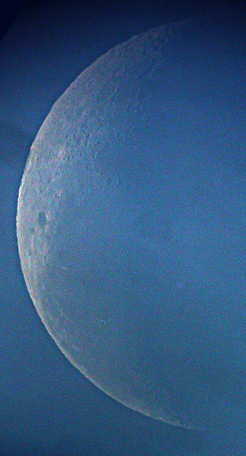 This rather poor image, which I took in the daytime (just after noon today), shows the moon
in an unusual state of libration, so that we can see more of its left edge than
usual.
Look at the prominent dark crater, which is named Grimaldi, and compare it to the position
of Grimaldi in
Fred Espenak's excellent eclipse pictures.
This rather poor image, which I took in the daytime (just after noon today), shows the moon
in an unusual state of libration, so that we can see more of its left edge than
usual.
Look at the prominent dark crater, which is named Grimaldi, and compare it to the position
of Grimaldi in
Fred Espenak's excellent eclipse pictures.
Libration happens mainly because the moon's orbit around the earth is not a circle.
It is an ellipse, so even though the moon keeps the same face toward the center of its
orbit, we get to peer around the visible edges just a little.
By peering around this particular edge at times of favorable libration, Patrick Moore discovered,
around 1946, that two lunar mountain ranges (the Cordilleras and the
Rook Mountains) were actually parts of concentric circles around a plain, which they
named Mare Orientale.
(He was actually not the first to notice this.)
Space probes later showed that Mare Orientale is a
spectacular
structure with many rings.
Astronomers with steadier, clearer air may have gotten a look at part of Mare Orientale
from earth this morning.
For more about the earthbound view, click here.

|
 |
2004
November
6
|
Hamfest!
|
Today all five of us (even Babbage the dog) went to the
Stone Mountain (Lawrenceville) Hamfest, an amateur radio
swap meet
that features a large "boneyard" (outdoor flea market) together
with indoor sales areas of varying levels of primitiveness.
This is a place where you can buy anything electronic, from 1930s
Atwater Kent radios (restored by devoted collectors) to slightly obsolete
laptop computers (which presently glut the market).
Radio gear predominates, but not as much as you'd think.
There is also a certain amount of current industrial surplus.
In the 1990s, we often went to hamfests as a family.
We had not done so since 1999, so today was a taste of old times
- all the more so, because unlike other hamfests in Georgia, this one hasn't
dwindled. Today it was at least as big as a decade ago.
Much of my test equipment came from hamfests circa 1990.
I bought it second- or third-hand and fixed it up - a fascinating endeavor - and
became somewhat notorious for my skill in reviving oscilloscopes
and making them work better than their designers foresaw.
Today, with no time to
devote to repairing curious old pieces of gear, I didn't buy much - just an
unusual extruded aluminum enclosure (which will one day hold some version
of Alcor),
an old magazine (for my Popular Electronics 1960s collection), and a
slightly out of date street atlas of Atlanta (cheap).
Cathy, however, bought 2 defunct oscilloscopes (for $2 each) and plans to
make at least one of them into an art project.
It will be a "betta-scope" containing a small aquarium with a betta fish.
(Bettas like small puddles and are happy in 500 mL of water.)
The controls will let the user vary the internal lighting.
I have the vague feeling I'm the object of a parody here...
|

|
Click on any picture to enlarge...
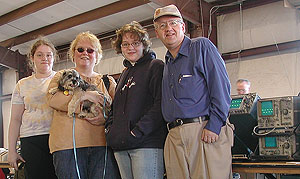
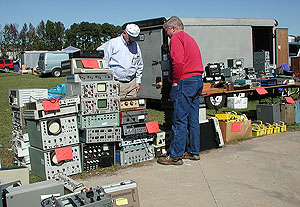
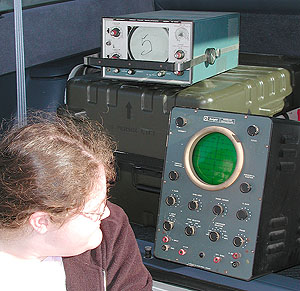
|
Later this evening I went to my favorite dark-sky site
and photographed airplanes
passing in front of the Veil Nebula (not intentionally), then ran
out of film. (Memorandum: The film counter on the Nikon F3 must have
been designed by Arabs; it reads right to left. The mark right before
35 is not 34; it is 36.) Chalk it up as a practice session; this was
my first dark-sky astrophotography trip since November 20, 2003.
That's how busy I've been!
To my delight I was able to achieve
polar alignment to within better than 0.25 degree using only the finderscope.
While the autoguider
chirped, I used 9x63 binoculars to get an excellent
view of the North America Nebula, as well as seeing the Veil Nebula through
binoculars for the first time.

|
 |
2004
November
5
|
They're selling what, exactly?
|
This ad appeared on Google while I was researching yesterday's entry.
I couldn't resist - eventually I clicked on it and got ads for 4 books
with Moral Issues in their titles.
There's a reason you don't see Google Ads on this page,
even though I'm making about $3 a day from them on other parts
of this site.
There's no telling what might sometimes happen.
For all I know, the Monica Lewinsky Fan Club would have popped up yesterday...
In any event, happy Guy Fawkes Day!
|

|

|

|
 |
2004
November
4
|
How the Democrats lost America
One of my old friends, a Massachusetts liberal, wrote to me this morning to lament
that the Democrats seem to feel that they are forbidden to profess any kind of
religious faith.
They seem to view all religion as an evil influence that needs to be exterminated.
Or - what amounts to the same thing - as something so "private" that it must not
influence one's public behavior.
We're starting to hear whining about how religious people ruined the country
by voting for Bush.
In a muted form, this message has appeared in the
mainstream media;
I've seen an uglier version of it in a wave of political newsgroup spam.
Why can't a Christian be a Democrat any more?
The Democrats have systematically excluded Christian voters in a number of ways:
- By excluding theologically conservative Christians from the Clinton administration.
This segment of America was simply unrepresented among Clinton's cabinet and advisors.
It seems to be equally absent from subsequent party leadership.
- By tolerating (and, I'm not kidding, sometimes voicing admiration for) the Clinton-Lewinsky
scandal. I've had Clinton's admirers tell me that a man's sex life is so "private" that it
doesn't reflect on his character. Then whose character does it reflect on?
- By refusing to say "no" to any left-wing special-interest group.
- By taking the leftmost possible position on moral controversies:
- Advocating "gay marriage" in a form that would rewrite existing marriage contracts,
employee benefits, and insurance policies;
- Saying they want abortion to be "rare" but opposing any restriction on it,
even on very late-term abortion, even though most Americans want abortion to be more
restricted than it presently is.
Senator Kerry's odd relationship with his church was the last straw.
Plenty of Presidents have been poor churchmen, but Kerry has insisted on being considered
a Catholic even while opposing, and actively working against, the Catholic Church's position
on abortion and other issues.
Why doesn't he have the integrity to leave a church whose teachings he positively rejects?
Kerry's backhanded churchmanship won him the distrust of numerous churchgoing Christians,
and some sincere adherents of other religions, who might not have
particularly objected to his politics.
Nobody criticizes Martin Luther King, Jr., or even Jimmy Carter for letting their
religion influence their politics.
But I don't think either of them would be welcome in the Democratic Party of today.
Afterthought: Only the gay activists have had the gumption to point out that the
biggest threat to the sanctity of marriage is our ultra-lenient divorce laws.
"No-fault divorce" is a stupid idea if the government is going to bother to register marriages
in the first place.
If you believe, as I do, that marriage is a covenant with society, not just
a temporary agreement with one's
spouse, then civil divorce should be somewhat difficult and
should require a legal finding of fault.

|
 |
2004
November
3
|
Joining the Digital Rebellion?
Melody and I have decided to give each other a
Canon Digital Rebel (EOS 300D) for
Christmas, and we ordered it today.
We are joining the vast horde of people who are getting this camera this year.
Part of the excuse for spending the money is to keep up our knowledge; we feel that if we don't master
this camera, an important step in photographic technology will have gone right past us.
We ordered from Adorama in New York, and we're
getting the USM version of the 18-55 lens (as normally bundled with the EOS 20D) instead of
the non-USM version, apparently less mechanically rugged, which normally comes with the Digital Rebel.
Adorama is the only reputable dealer I can find that is selling them separately.
As I've noted before, this is the first low-priced ($1000) digital SLR that
performs well for
astronomy.
It has considerable
hacker appeal and has
attracked a loyal following of experimenters.
This does not necessarily mean I'm Canonizing my whole camera setup.
For now, the film cameras and lenses remain all Nikon, and I'll be
using a
Nikon to Canon lens adapter
for astrophotography.
The EOS has a shallow body and can be adapted to take lots of other cameras' lenses
without aperture coupling or autoexposure.
Canon has published a nice book,
EF Lens Work III,
detailing all their current lenses (with MTF curves!) and the
underlying technology.
This book very much resembles the classic
Olympus OM System Lens Handbook
and I wonder if the same marketing people are behind it.
[Late update: Probably not. Canon published an earlier Lens Work book the same year
Olympus published their handbook.
Curiously, none of these lens books has an ISBN; they were/are sold only through camera stores,
not through the book trade.]

|
 |
2004
November
2
|
Voting, photography, etc.
 Despite Georgia's rumored "record turnout," I didn't have to stand in line to vote today.
Neither did Cathy. Our polling place, Timothy Baptist Church, handled everything very efficiently.
Despite Georgia's rumored "record turnout," I didn't have to stand in line to vote today.
Neither did Cathy. Our polling place, Timothy Baptist Church, handled everything very efficiently.
As I've said before, I don't trust electronic voting machines because there is absolutely
no limit to the shenanigans that could be programmed into them.
I like punched-card ballots best.
Mechanical voting machines are OK because there are mechanics in every town who can verify that
they work properly, and they're not complicated enough for elaborate tricks to be possible.
But the firmware in an electronic voting machine is visible only to its manufacturer - and why
should our state's political future be in the hands of one manufacturer?
I've just returned from a short trip out of town.
Before leaving, on Saturday, I managed to do a bit of darkroom work
(the first since November 2003).
To my delight the chemicals hadn't gone bad.
(Well, most of them hadn't.)
The picture at the right is actually from last November's darkroom session.
It's the kind of picture I take to amuse myself; I have no idea if anyone else
considers it "art."
The water jugs formed a striking pattern of light and shadow.
While in Atlanta I visited
Showcase Photo, which,
of all the major Atlanta photo dealers, seems to be the one most focused on people
who actually enjoy taking pictures.
Their darkroom section had shrunk to a third of its recent size.
There was still just enough.
But at the current rate of shrinkage, we're in our last 5 years of being able to buy film
easily and get it processed.
I think old-fashioned black-and-white materials will survive longest, as an art medium,
because they're simple, and because they resemble photomechanical processes that are still
used in industry.
So what did I look at? Digital SLRs, of course, and color calibration equipment for computers.
Digital has arrived!

|
 |
2004
November
1
|
Another laptop stand

|
|
Here's a smaller, glueless version of the laptop stand I built last month.
The pieces fit together by pressure and can be disassembled.
The longest pieces are only 6 1/2 inches long.
The small brown dots are rubber feet, placed to keep the stand from scratching
the computer.
By "laptop stand" I mean a gadget for holding your laptop when you put it down
at the foot of your chair - not when you are using it!
|

|
 |


![]()


 I want to wish everyone a happy Thanksgiving Day. For those outside the U.S., I should explain
that this is the day we traditionally spend feasting on turkey and (if we're pious enough) thanking
God for His blessings.
I want to wish everyone a happy Thanksgiving Day. For those outside the U.S., I should explain
that this is the day we traditionally spend feasting on turkey and (if we're pious enough) thanking
God for His blessings.




 One of the purposes of this notebook is to record useful technical information so
that other people can find it. Accordingly, here are some notes on how to use a
non-Canon (and not Canon-dedicated) flash unit with the EOS Digital Rebel (EOS 300D).
One of the purposes of this notebook is to record useful technical information so
that other people can find it. Accordingly, here are some notes on how to use a
non-Canon (and not Canon-dedicated) flash unit with the EOS Digital Rebel (EOS 300D).
 Our new Canon Digital Rebel came today - and, apparently, just in the nick of time,
because some slide film I had sent to my regular lab,
Our new Canon Digital Rebel came today - and, apparently, just in the nick of time,
because some slide film I had sent to my regular lab,
 This is perhaps the worst astrophoto image I've ever shared with the public,
but it records an interesting event.
Yesterday morning the moon passed in front of Jupiter
(the bright spot at the lower right).
This is perhaps the worst astrophoto image I've ever shared with the public,
but it records an interesting event.
Yesterday morning the moon passed in front of Jupiter
(the bright spot at the lower right).
 I spent the last 2 evenings setting up color management on our Epson R300 printer
and the computer attached to it.
I spent the last 2 evenings setting up color management on our Epson R300 printer
and the computer attached to it.
 This rather poor image, which I took in the daytime (just after noon today), shows the moon
in an unusual state of libration, so that we can see more of its left edge than
usual.
Look at the prominent dark crater, which is named Grimaldi, and compare it to the position
of Grimaldi in
This rather poor image, which I took in the daytime (just after noon today), shows the moon
in an unusual state of libration, so that we can see more of its left edge than
usual.
Look at the prominent dark crater, which is named Grimaldi, and compare it to the position
of Grimaldi in




 Despite Georgia's rumored "record turnout," I didn't have to stand in line to vote today.
Neither did Cathy. Our polling place, Timothy Baptist Church, handled everything very efficiently.
Despite Georgia's rumored "record turnout," I didn't have to stand in line to vote today.
Neither did Cathy. Our polling place, Timothy Baptist Church, handled everything very efficiently.
